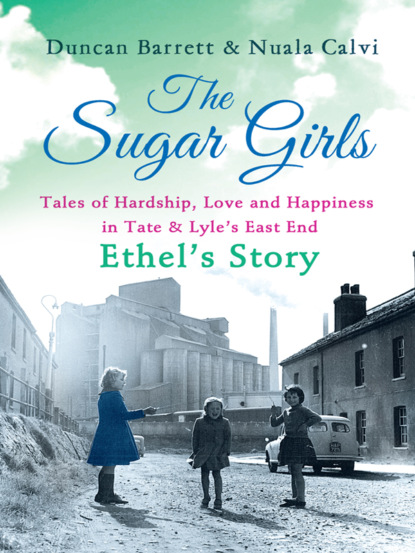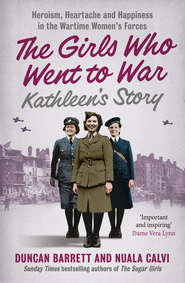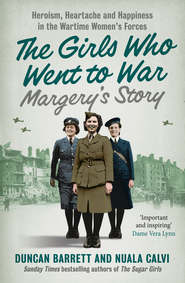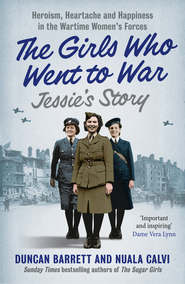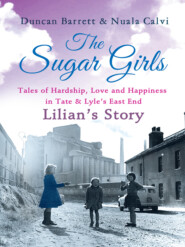По всем вопросам обращайтесь на: info@litportal.ru
(©) 2003-2024.
✖
The Sugar Girls – Ethel’s Story: Tales of Hardship, Love and Happiness in Tate & Lyle’s East End
Настройки чтения
Размер шрифта
Высота строк
Поля
The Sugar Girls – Ethel’s Story: Tales of Hardship, Love and Happiness in Tate & Lyle’s East End
Duncan Barrett
Nuala Calvi
This is Ethel’s story, one of four stories from The Sugar Girls. During the Blitz and the years of rationing, the Sugar Girls kept Britain sweet. The work was back-breakingly hard, but the Tate & Lyle factory was more than just a workplace - it was a community, a calling, a place of love and support and an uproarious, tribal part of East London.‘On an autumn day in 1944, Ethel Alleyne walked the short distance from her house to Tate & Lyle’s refinery on the shining curve of the Thames. Looking up at the giant gates, Ethel felt like she had been preparing for this moment all her life. She smoothed down her frizzy hair, scraped a bit of dirt off the corner of her shoe and strode through.She was quite unprepared for the sight that met her eyes …’In the years leading up to and after the Second World War thousands of women left school at fourteen to work in the bustling factories of London’s East End. Despite long hours, hard and often hazardous work, factory life afforded exciting opportunities for independence, friendship and romance. Of all the factories that lined the docks, it was at Tate & Lyle’s where you could earn the most generous wages and enjoy the best social life, and it was here where The Sugar Girls worked.This is an evocative, moving story of hunger, hardship and happiness, providing a moving insight into a lost way of life, as well as a timeless testament to the experience of being young and female.Includes Ethel’s own personal photographs of life as a sugar girl.
Duncan Barrett & Nuala Calvi
The Sugar Girls: Ethel’s Story
Tales of Hardship, Love and Happiness in Tate & Lyle’s East End
Dedication
For Margaret Denby
Contents
Title Page
Dedication
Preface
Map
1
2
3
4
5
6
7
8
Epilogue
Acknowledgements
Pictures (#litres_trial_promo)
About the Authors
Copyright
About the Publisher
Preface
Heading east out of the City of London, just past Poplar and the Isle of Dogs, you’ll find the artificial peninsula of Silvertown: a narrow strip of land two and a half miles long, sandwiched between the Royal Docks and the broad sweep of the Thames.
By the mid-twentieth century this area was home to a score of factories, from British Oil & Cake Mills at one end to Henley’s Cable Works at the other. The factories were a major employer, both for people living in the rows of slum houses in Silvertown and those in the surrounding areas north of the docks: Canning Town, Custom House and Plaistow. While the thriving docks provided work for the men in the local community, the factories offered employment for women as well.
When working-class girls left school there were a limited number of options available to them: dressmaking, service, clerical work perhaps, and, for the vast majority, a job in a factory. With the near full employment that followed the Second World War, most young people could simply take themselves along to a factory of their choice, ask for work and be hired on the spot. If they found they didn’t like it there, they could walk out at lunchtime and be taken on somewhere else before tea.
Among the most sought-after factories to work at were the two operated by Tate & Lyle, the Plaistow Wharf and Thames refineries, at either end of the Sugar Mile (so called because, in addition to the sugar and syrup they produced, Keiller’s jam factory was also located there). Tate & Lyle offered the best wages, generous bonuses three times a year, and a social life that was unrivalled in the neighbourhood thanks to the Tate Institute, a subsidised bar and entertainment hall. Unsurprisingly, the company inspired fierce loyalty among its employees – many young men and women working there in the post-war years were the fourth generation of their families to do so.
There were plenty of positions for young ‘sugar girls’, thanks to the many female-dominated departments: the great sugar-packing operation known as the Hesser Floor, the Blue Room where the sheets of paper were printed for the sugar bags, and the can-making and syrup-filling floors where the tins of Lyle’s Golden Syrup were put together and filled. The jobs could be heavy, exhausting and repetitive, but for the women who undertook them the rewards outweighed the hardships. Most stayed until they married or fell pregnant (the rules varied between departments as to when they were forced to leave). Nearly all of them looked back on their time at the factories as a kind of golden era in their lives – of independence, friendship and romance, before the responsibilities of marriage and motherhood took over.
Originally the two refineries had been run by rival companies. Henry Tate, a Liverpool grocer turned sugar magnate, put up his London factory in 1878, when much of Silvertown was still marshland. His great business adversary was Abram Lyle, who opened his own sugar and syrup factory a mile upstream five years later. Lyle was a pious Scot whose ruddy cheeks belied his commitment to teetotalism: he once declared he would rather see a son of his carried home dead than drunk.
For many decades the two firms competed in sugar production, but with an important unspoken agreement: the Lyles would not encroach on Tate’s trademark cubed sugar, while the Tates would not produce a single drop of the golden syrup the Lyles had invented. But a cold war developed between them, and when the Lyles heard rumours that the Tates were about to launch a syrup onto the market, they hastily knocked together a cube plant in response. Leaking word of its existence was enough to ensure that it never had to be used.
The families were scrupulous in keeping up professional boundaries – although the senior Tates and Lyles took the same train from Fenchurch Street Station every morning, they made sure to sit in separate carriages, and never acknowledged each other.
By the end of the First World War it was clear that the competition was actually hurting both companies, but neither had a clear upper hand: the Lyles had the edge in profitability, but the Tates’ output was not to be rivalled. A merger was the obvious way forward. Negotiations began, and for three years Ernest Tate and Charles Lyle tore their hair out in frustration as proposal after proposal was rejected by their respective boards. A deal was finally agreed in 1921.
The new Tate & Lyle company retained both London factories – Tate’s Thames Refinery in the heart of Silvertown and Lyle’s Plaistow Wharf Refinery a mile upriver. The management of the two factories, however, remained in the hands of the respective families. The original Tate and Lyle, Henry and Abram, were both long dead by now, and had never known the fate of their companies. In fact, they had never even met.
The old rivalry didn’t die out completely, though, and from 1937 onwards it was played out in a more friendly fashion, on the company’s new shared sports ground. There, the workers from ‘Tates-es’ and ‘Lyles-es’ (as the two factories continued to be known by the locals) would compete against each other in football and cricket.
The Second World War brought great changes to both refineries, as their workforces became female-dominated for the first time. As men were called up, the management were forced to blur the strict distinctions between ‘men’s’ and ‘women’s’ jobs, with female workers tackling even the most physically demanding and high-status roles, including that of the panmen who boiled up the sugar liquor. The women were thrilled to see their wages go up when they took on such new jobs, but they were still only paid 75 per cent of what their male counterparts had earned.
After the war the men reclaimed their old roles, but a shift had taken place and the crucial part that the sugar girls played in the company’s success could no longer be ignored. In 1948 a mixed-sex canteen was built at the Plaistow Wharf Refinery, and for the first time the women were able to eat alongside their male colleagues.
Today, after the closure of the docks and almost all of the local factories, much of Silvertown has the feeling of a ghost town. It is overshadowed by the planes taking off and landing at City Airport – whose runway cuts between the Royal Albert and King George V docks – and the looming concrete viaducts of the Docklands Light Railway. Many of the old Victorian terraces have been replaced by blocks of council flats, and the pubs, shops and cafés that once lined the North Woolwich Road opposite the Plaistow Wharf Refinery are all gone. The close-knit neighbourhoods, and the way of life that once thrived there, have vanished and can never be recovered.
Tate & Lyle is unusual in having retained its Silvertown factories, although from the late 1960s much of the Plaistow Wharf Refinery was demolished as its sugar refining activities were wound down. Many loyal workers took redundancy rather than accept a transfer downriver to the Thames Refinery. Even there, the company now employs only a small fraction of its former workforce, and the jobs once done by the sugar girls are all performed by machines.
Tate & Lyle has long since stopped being a family firm, and in 2010 it was bought by an American sugar giant. However, the legacy of its original founders lives on. In 2006 the iconic Lyle’s Golden Syrup tins were officially recognised by the Guinness Book of Records as the oldest brand in Britain. Meanwhile, the philanthropic work of the Tate family is remembered in the libraries and art galleries that bear its name.
But the contribution of the sugar girls, those ordinary young women who played such a central role during Tate & Lyle’s East End heyday, is not widely recognised, and their lives have not generally been recorded. Until now.
Map
1
On a crisp September day in 1944, Ethel Alleyne stood outside Tate & Lyle’s Plaistow Wharf refinery, looking up at the giant gate with its elaborate wrought iron and shining white clock.
A wiry, frizzy-haired girl with light-brown skin and keen dark eyes, she was wearing her best dress for the occasion – black with red trimmings. In one hand she clutched her headmaster’s testimonial, already proudly committed to memory:
Ethel’s attendance has been regular and punctual. She is a very willing, cheerful girl, always ready to give her best. Her neatness and tidiness and general attention to detail are very pleasing. I can recommend her to any employer as a conscientious worker.
Duncan Barrett
Nuala Calvi
This is Ethel’s story, one of four stories from The Sugar Girls. During the Blitz and the years of rationing, the Sugar Girls kept Britain sweet. The work was back-breakingly hard, but the Tate & Lyle factory was more than just a workplace - it was a community, a calling, a place of love and support and an uproarious, tribal part of East London.‘On an autumn day in 1944, Ethel Alleyne walked the short distance from her house to Tate & Lyle’s refinery on the shining curve of the Thames. Looking up at the giant gates, Ethel felt like she had been preparing for this moment all her life. She smoothed down her frizzy hair, scraped a bit of dirt off the corner of her shoe and strode through.She was quite unprepared for the sight that met her eyes …’In the years leading up to and after the Second World War thousands of women left school at fourteen to work in the bustling factories of London’s East End. Despite long hours, hard and often hazardous work, factory life afforded exciting opportunities for independence, friendship and romance. Of all the factories that lined the docks, it was at Tate & Lyle’s where you could earn the most generous wages and enjoy the best social life, and it was here where The Sugar Girls worked.This is an evocative, moving story of hunger, hardship and happiness, providing a moving insight into a lost way of life, as well as a timeless testament to the experience of being young and female.Includes Ethel’s own personal photographs of life as a sugar girl.
Duncan Barrett & Nuala Calvi
The Sugar Girls: Ethel’s Story
Tales of Hardship, Love and Happiness in Tate & Lyle’s East End
Dedication
For Margaret Denby
Contents
Title Page
Dedication
Preface
Map
1
2
3
4
5
6
7
8
Epilogue
Acknowledgements
Pictures (#litres_trial_promo)
About the Authors
Copyright
About the Publisher
Preface
Heading east out of the City of London, just past Poplar and the Isle of Dogs, you’ll find the artificial peninsula of Silvertown: a narrow strip of land two and a half miles long, sandwiched between the Royal Docks and the broad sweep of the Thames.
By the mid-twentieth century this area was home to a score of factories, from British Oil & Cake Mills at one end to Henley’s Cable Works at the other. The factories were a major employer, both for people living in the rows of slum houses in Silvertown and those in the surrounding areas north of the docks: Canning Town, Custom House and Plaistow. While the thriving docks provided work for the men in the local community, the factories offered employment for women as well.
When working-class girls left school there were a limited number of options available to them: dressmaking, service, clerical work perhaps, and, for the vast majority, a job in a factory. With the near full employment that followed the Second World War, most young people could simply take themselves along to a factory of their choice, ask for work and be hired on the spot. If they found they didn’t like it there, they could walk out at lunchtime and be taken on somewhere else before tea.
Among the most sought-after factories to work at were the two operated by Tate & Lyle, the Plaistow Wharf and Thames refineries, at either end of the Sugar Mile (so called because, in addition to the sugar and syrup they produced, Keiller’s jam factory was also located there). Tate & Lyle offered the best wages, generous bonuses three times a year, and a social life that was unrivalled in the neighbourhood thanks to the Tate Institute, a subsidised bar and entertainment hall. Unsurprisingly, the company inspired fierce loyalty among its employees – many young men and women working there in the post-war years were the fourth generation of their families to do so.
There were plenty of positions for young ‘sugar girls’, thanks to the many female-dominated departments: the great sugar-packing operation known as the Hesser Floor, the Blue Room where the sheets of paper were printed for the sugar bags, and the can-making and syrup-filling floors where the tins of Lyle’s Golden Syrup were put together and filled. The jobs could be heavy, exhausting and repetitive, but for the women who undertook them the rewards outweighed the hardships. Most stayed until they married or fell pregnant (the rules varied between departments as to when they were forced to leave). Nearly all of them looked back on their time at the factories as a kind of golden era in their lives – of independence, friendship and romance, before the responsibilities of marriage and motherhood took over.
Originally the two refineries had been run by rival companies. Henry Tate, a Liverpool grocer turned sugar magnate, put up his London factory in 1878, when much of Silvertown was still marshland. His great business adversary was Abram Lyle, who opened his own sugar and syrup factory a mile upstream five years later. Lyle was a pious Scot whose ruddy cheeks belied his commitment to teetotalism: he once declared he would rather see a son of his carried home dead than drunk.
For many decades the two firms competed in sugar production, but with an important unspoken agreement: the Lyles would not encroach on Tate’s trademark cubed sugar, while the Tates would not produce a single drop of the golden syrup the Lyles had invented. But a cold war developed between them, and when the Lyles heard rumours that the Tates were about to launch a syrup onto the market, they hastily knocked together a cube plant in response. Leaking word of its existence was enough to ensure that it never had to be used.
The families were scrupulous in keeping up professional boundaries – although the senior Tates and Lyles took the same train from Fenchurch Street Station every morning, they made sure to sit in separate carriages, and never acknowledged each other.
By the end of the First World War it was clear that the competition was actually hurting both companies, but neither had a clear upper hand: the Lyles had the edge in profitability, but the Tates’ output was not to be rivalled. A merger was the obvious way forward. Negotiations began, and for three years Ernest Tate and Charles Lyle tore their hair out in frustration as proposal after proposal was rejected by their respective boards. A deal was finally agreed in 1921.
The new Tate & Lyle company retained both London factories – Tate’s Thames Refinery in the heart of Silvertown and Lyle’s Plaistow Wharf Refinery a mile upriver. The management of the two factories, however, remained in the hands of the respective families. The original Tate and Lyle, Henry and Abram, were both long dead by now, and had never known the fate of their companies. In fact, they had never even met.
The old rivalry didn’t die out completely, though, and from 1937 onwards it was played out in a more friendly fashion, on the company’s new shared sports ground. There, the workers from ‘Tates-es’ and ‘Lyles-es’ (as the two factories continued to be known by the locals) would compete against each other in football and cricket.
The Second World War brought great changes to both refineries, as their workforces became female-dominated for the first time. As men were called up, the management were forced to blur the strict distinctions between ‘men’s’ and ‘women’s’ jobs, with female workers tackling even the most physically demanding and high-status roles, including that of the panmen who boiled up the sugar liquor. The women were thrilled to see their wages go up when they took on such new jobs, but they were still only paid 75 per cent of what their male counterparts had earned.
After the war the men reclaimed their old roles, but a shift had taken place and the crucial part that the sugar girls played in the company’s success could no longer be ignored. In 1948 a mixed-sex canteen was built at the Plaistow Wharf Refinery, and for the first time the women were able to eat alongside their male colleagues.
Today, after the closure of the docks and almost all of the local factories, much of Silvertown has the feeling of a ghost town. It is overshadowed by the planes taking off and landing at City Airport – whose runway cuts between the Royal Albert and King George V docks – and the looming concrete viaducts of the Docklands Light Railway. Many of the old Victorian terraces have been replaced by blocks of council flats, and the pubs, shops and cafés that once lined the North Woolwich Road opposite the Plaistow Wharf Refinery are all gone. The close-knit neighbourhoods, and the way of life that once thrived there, have vanished and can never be recovered.
Tate & Lyle is unusual in having retained its Silvertown factories, although from the late 1960s much of the Plaistow Wharf Refinery was demolished as its sugar refining activities were wound down. Many loyal workers took redundancy rather than accept a transfer downriver to the Thames Refinery. Even there, the company now employs only a small fraction of its former workforce, and the jobs once done by the sugar girls are all performed by machines.
Tate & Lyle has long since stopped being a family firm, and in 2010 it was bought by an American sugar giant. However, the legacy of its original founders lives on. In 2006 the iconic Lyle’s Golden Syrup tins were officially recognised by the Guinness Book of Records as the oldest brand in Britain. Meanwhile, the philanthropic work of the Tate family is remembered in the libraries and art galleries that bear its name.
But the contribution of the sugar girls, those ordinary young women who played such a central role during Tate & Lyle’s East End heyday, is not widely recognised, and their lives have not generally been recorded. Until now.
Map
1
On a crisp September day in 1944, Ethel Alleyne stood outside Tate & Lyle’s Plaistow Wharf refinery, looking up at the giant gate with its elaborate wrought iron and shining white clock.
A wiry, frizzy-haired girl with light-brown skin and keen dark eyes, she was wearing her best dress for the occasion – black with red trimmings. In one hand she clutched her headmaster’s testimonial, already proudly committed to memory:
Ethel’s attendance has been regular and punctual. She is a very willing, cheerful girl, always ready to give her best. Her neatness and tidiness and general attention to detail are very pleasing. I can recommend her to any employer as a conscientious worker.





